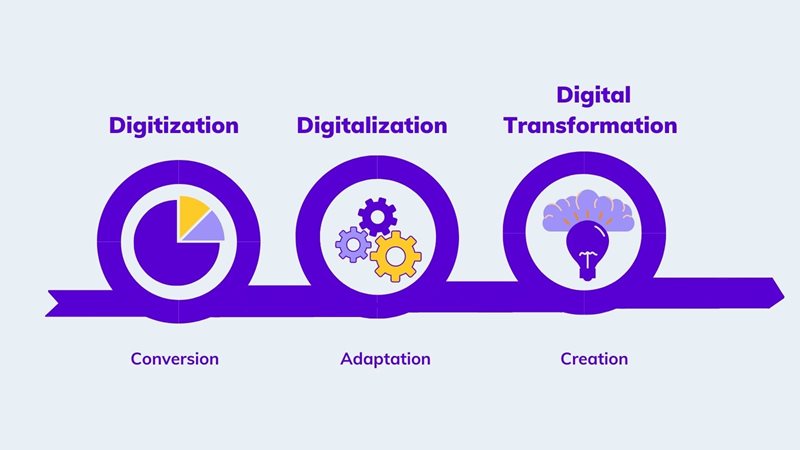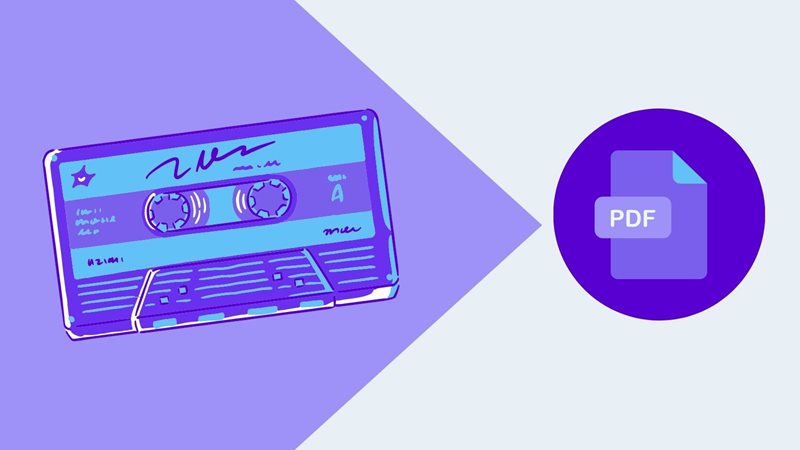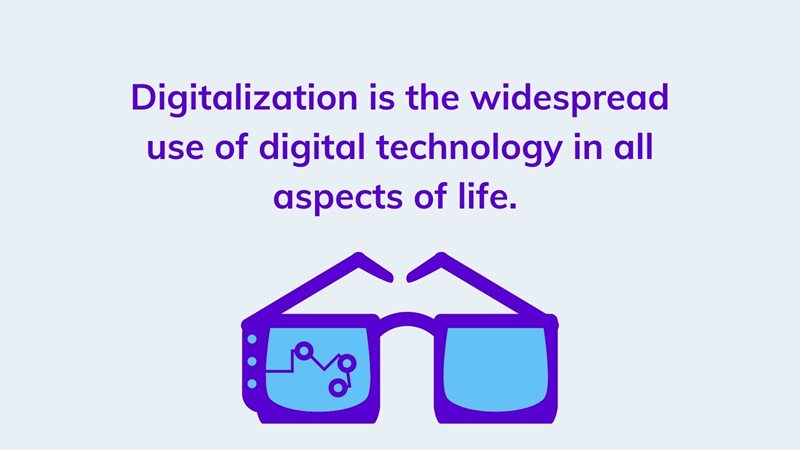Digitization vs Digitalization vs Digital Transformation
The word digitization, digitalization, and digital transformation are used interchangeably. While the sounding is pretty similar, the meaning of each word is way different.
Companies often use these words to refer to different activities, goals, and purposes of the business itself. This is why understanding the essence of digitization, digitalization, and digital transformation can help you better understand the digital world that we live in today.
Learning the difference between these words is important because it can help you understand different aspects of the digital world. For example, if you know the difference between digitization and digitalization, you can use a computer to design products effectively. Or, if you understand the difference between digitalization and digital transformation, you can learn how a company is changing its business model.
So, what’s the difference?

Mục lục bài viết
Digitization
Digitization refers to the process of converting analog data into digital form. This can be anything from images, videos, audio, or text. When something is digitized, it becomes easy to store, access, and share with the world.
Analog data is any physical information that takes up space, like a picture or a sound recording. Converting this information into digital form means that it can be stored and manipulated using a computer.
Example of digitization:
- Converting a picture of a cat into digital images that can be stored on the computer.
- Converting manual reading of a book into an electronic book or text so you can read on the screen, performing a search, highlighting text, and more.
- Scanning printed documents and storing them in the form of WORD or PDF.
- Converting technical books into explainer videos to help you understand the information easier.

The Benefits of Digitization
Digitization has become an essential aspect of our life in the digital age. Here are some of the benefits of digitization:
1. Convenience
With everything being digitized, it’s easy to find what you’re looking for and access it from anywhere in the world. For example, if you have a digitized book, you can read it while also finding specific sentences without turning each page. You’re able to search through the book using keywords and discover the result. You may as well highlight important notes and use them later.
2. Cost-effective and efficiency
Digitizing information can often be cheaper than keeping and managing physical copies. That’s because physical data takes a bigger store to keep. Hence, the highest cost.
More importantly, you can’t bring the physical store along with you when you travel. As a result, you can’t always access the information anytime you want. When analog data is digitized, it becomes easier to process and analyze. This can lead to faster decisions and better outcomes.
3. Accuracy
Digital data is often more accurate than analog data because there is no chance of human error.
When you digitize data, you can reduce the possibility of mistakes that can be made if you handle information manually. That’s why converting analog data into digital elements is a must since it helps minimize any errors and improves the authenticity of the information.
4. Accessibility
Digitized information is available to anyone with a computer and an internet connection. Everyone from around the world can access the information anytime they want.
The ability to access files in a remote area where no physical activities involve can help with the business performance and overall conduct in different industries. Remote work monitoring is possible with digitization because you access and track the task anywhere.
5. Preservation
Digitizing information can help preserve it for future generations. If you’ve digitized data, you ensure its availability in the future years. Digitization allows you to store information safely and seamlessly. You’re able to access and find the same file years after you’ve created it.
Digitalization
Digitalization is the widespread use of digital technology in all aspects of life. This could include using computers to do things like banking and shopping or having a digital device like a phone or an e-reader to read books.
It is the process of leveraging digitized products into something more that boosts performance, increases revenues, changes business models, and more.

The Applications of Digitalization
Digitalization is the process of using digital technology to change how something works. For example, you can use a computer to design a car instead of traditional methods. This method helps businesses save money and become efficient in performing work.
Companies can use digitalization to:
1. Automate processes
This means that tasks can be completed automatically using computers. For example, you could use a computer to automatically fill out a form or order products online.
This can be done if you’ve digitized your work by typing the information on Microsoft Excel or Google Sheet. You can then use the stored data to automatically fill out the form whenever you encounter a submission box on the internet.
2. Transform business models
Digitalization can help companies change the way they do business. For example, a company might move from selling products to providing services. Previously, this company sold digital products like CDs, and instead of selling them the way they are, the company can transform its business model entirely.
It starts moving all the content from the CDs and uploads them on Google clouds. The company will then allow customers to access the file at a certain time by offering subscription fees.
3. Create new products and services
Digital technology can help companies create new products and services that wouldn’t be possible with traditional methods. However, digitalization makes it real by building an entirely new business model that customers can use the product easily.
4. Reach new markets
Digitalization transforms your existing business model and products so that they can be used in new markets. You can use digital technology to create new versions of your products tailored to the market you’re trying to reach.
Businesses can gain insights into their customers, products, and operations by digitizing data. This data can be used to change their marketing strategy to connect with new audiences.
5. Improve efficiency
With digitalization, companies can become more efficient in how they operate. The new outlook helps businesses save time and money. For example, digital technology like PPC management software allows you to access marketing campaigns quickly, complete the work at the scheduled time, collaborate, and delegate tasks with teammates at your fingertips. This can lead to cost savings and improved quality.
Digital Transformation
Digital transformation uses digital technology to change how an organization works from top to bottom. It is the evolution of business processes and models to take advantage of opportunities offered by digital technology. This includes changing how employees work, how customers are served, and how the company is run.
The goal of digital transformation is to use digital technology to create a more efficient and effective organization. This can lead to cost savings, improved quality, and increased profits.
Digital transformation takes digitization and digitalization a step further by using digital technology to completely change how a business operates. For example, a company might move from selling products in stores to only selling online.
There are three steps in digital transformation:

1. Assessment (organizational transformation)
The first step is to assess how digital technology can be used to improve the organization. This includes looking at the current state of the business and how it can be improved. This type of transformation changes how the organization is run from top to bottom. It usually involves using technology to change how work is done and how customers are served.
2. Planning (process transformation)
The second step is to develop a plan for using digital technology. This includes deciding which processes need to be changed and how the technology will be implemented. This type of transformation changes how business processes are completed. It usually involves using technology to automate or simplify tasks.
The third step is to execute the plan by implementing the digital technology and changing how employees work, and customers are served. This type of transformation focuses on adopting new technologies to improve the organization. It usually involves using technology to improve communication, collaboration, or decision-making.
The Benefits of Digital Transformation
1. Cost savings
Digital technology can help companies reduce the costs of doing business. For example, a company might move from using physical documents to using electronic documents, which can save money on paper, printing, and shipping costs.
2. Improved quality
Digital technology can help companies improve the quality of their products and services. For example, a company might move from using manual processes to using automated processes, leading to improved quality and reduced errors.
3. Increased profits
Digital technology can help companies increase their profits by helping them become more efficient and effective. For example, a company might be able to reduce the amount of time it takes to complete a task or reach new markets.
4. Improved customer service
Digital technology can help companies improve the quality of their customer service. For example, a company might be able to provide real-time support or personalized recommendations through eCommerce Facebook ads that allow customers to find their needs by checking your promotion.
5. Increased innovation
Digital technology can help companies increase the rate at which they innovate by making it easier to experiment and test new ideas.
6. Enhanced safety
Digital technology can help companies improve the safety of their employees and products. For example, a company might be able to reduce the risk of accidents by using sensors to monitor the environment.

How Businesses Can Leverage Digitization, Digitalization, and Digital Transformation
Now you know the difference between digitization, digitalization, and digital transformation. It’s time to unpack what aspects can be improved using these activities and how companies can perform better with these terms.
Digitization
For digitization, businesses should assess what areas or departments can be improved with technology upgrades to make work easier and faster. For example, upgrading an accounts payable system to include scanning and automated data entry can speed up the process of paying bills.
In some cases, automating a process can completely take it over so that employees are no longer needed for the task (such as online order-taking and payment processing).
Businesses should embrace the fact that digitization can replace workforces in certain fields one day. While it sounds terrifying for those working on replaceable jobs, digitization helps businesses achieve a goal faster and efficiently with minimized human errors.
Digitalization
When it comes to digitalization, businesses should consider how customer service might be upgraded with new technologies. This includes looking at how customer interactions can be made more personal through the use of chatbots or virtual assistants and how products can be marketed and sold through digital channels only.
Additionally, many companies use digitalization to move from a linear production model to a circular one where products can be recycled and reused.
A simple yet powerful tactic such as having an online presence or opening an online store can be identified as digitalization. This helps brands market and reach out to a bigger audience relatively easily.
Digital Transformation
For digital transformation, businesses should think about how they can use technology to enable new ways of working. This includes looking at how tasks can be automated or streamlined and how different teams can collaborate using collaboration tools more effectively. Additionally, companies often use digital transformation to drive innovation by adopting new technologies like the Internet of Things (IoT), artificial intelligence (AI), and machine learning.
When it comes to leveraging digitization, digitalization, and digital transformation, the possibilities are endless. By understanding the difference between these terms and exploring how technology can improve different areas of their business, companies can begin to see a real difference in their performance.
Final Thoughts
Digital technology has had a profound impact on the way businesses operate. Through digitization, companies can upgrade their technology systems to make work easier and faster. Digitalization involves using technology to personalize customer service and sell products through digital channels. And digital transformation is about using technology to enable new ways of working and driving innovation.
These terms sound unsurprisingly similar in that many are confused with differentiating between each other. Understanding the difference, specifically, their use in business, can help improve one in optimizing the company. After all, each has its own meaning and purpose. You shouldn’t mix them up because it can affect how you operate the business itself.
Once you know the differences, it’s easy to start using these terms interchangeably without mixing everything. More importantly, you can optimize your strategy and achieve your goals easily. By leveraging these three activities, businesses can see a real difference in their performance, such as increased leads, higher revenues, and massive public recognition.











